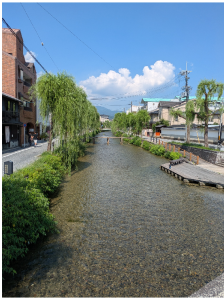Kyoto City Enforces Japan’s Highest Accommodation Tax 1
Yoshie Doi

Photographed on August 30, 2025
Since 2003, the “Year of Inbound Tourism,” Japan has incorporated tourism-oriented policies into its policies, and Kyoto has also implemented various policies through trial and error to get to where it is today. Kyoto has a sophisticated and extremely powerful brand, which is undoubtedly the accumulation of history and culture that has come from being the capital for 1,074 years. I would like to propose that it is time to once again rebuild Kyoto’s brand power and consider how to protect and pass on these assets.
Many tourists say that experiencing and enjoying Kyoto’s relaxed atmosphere soothes both body and mind. The city of Kyoto, surrounded by mountains on three sides and with a gently flowing river, is home to a rich history and culture that has shaped this atmosphere, and is visited by many tourists from overseas. What Kyoto has that no other city has is its 1,074 years of history and culture as the capital. The essence of this history and culture is overflowing in Kyoto.
Kyoto Gyoen National Garden is located in the center of Kyoto City and is now a national park that is open 24 hours a day, 365 days a year. There is no admission fee. It is managed by the Kyoto Gyoen Management Office of the Ministry of the Environment. The vast grounds are covered with gravel, and instead of concrete, we can smell the natural earth. Kyoto residents can visit it at any time and spend a luxurious time there.
Recently, we have seen an increase in inbound tourists taking walks, and we feel that they are becoming more interested in Kyoto’s scenery and culture. Due to the concentration of tourists in the central Kyoto area, city buses have shifted focus from serving local residents to serving tourists, and thanks to the efforts of the Kyoto Transportation Bureau, tourist express buses have been created, but there have been many times when more than half of the passengers on city buses were inbound tourists.
At bus stops and private railway stations, there are many inbound passengers, many more than Japanese people, and people using elevators pass by tourists commuting to work. Unbelievable scenes can be seen, such as the garbage problem on Shijo Street in Gion, but we need to sort out the issues and build a cooperative system with the government, citizens, and businesses to overcome them.
The Ministry of Internal Affairs and Communications has approved an increase in Kyoto City’s accommodation tax, which will come into effect in March 2014. The accommodation tax was introduced in 2018 as part of an effort to boost tourism and improve Kyoto’s unique attractions, including its culture and scenery, thereby increasing the satisfaction of both residents and tourists.
In recent years, as tourism demand has recovered since the COVID-19 pandemic, tourism issues have often disrupted the lives of citizens, and we would like to find ways to achieve a win-win situation for citizens, tourists, and businesses alike.
Kyoto residents have special benefits when it comes to tourism. If you look at the website “Link! Link! Link!”, a portal site that connects daily life and tourism, you will find that if you present proof of Kyoto citizenship, you can get 20%, 15%, or 10% off at facilities, restaurants, etc. What’s more, there are also special free or half-price prices for residents, so be sure to check it out.
https://link.kyoto.travel/special-offer/
Many people may not know that Kyoto City offers such a service. Overtourism has its downsides, such as passengers being left behind on city buses, but Kyoto residents should work together with the government and businesses to overcome this situation. (Continued)
The end of document
Translated by Masami Otani
